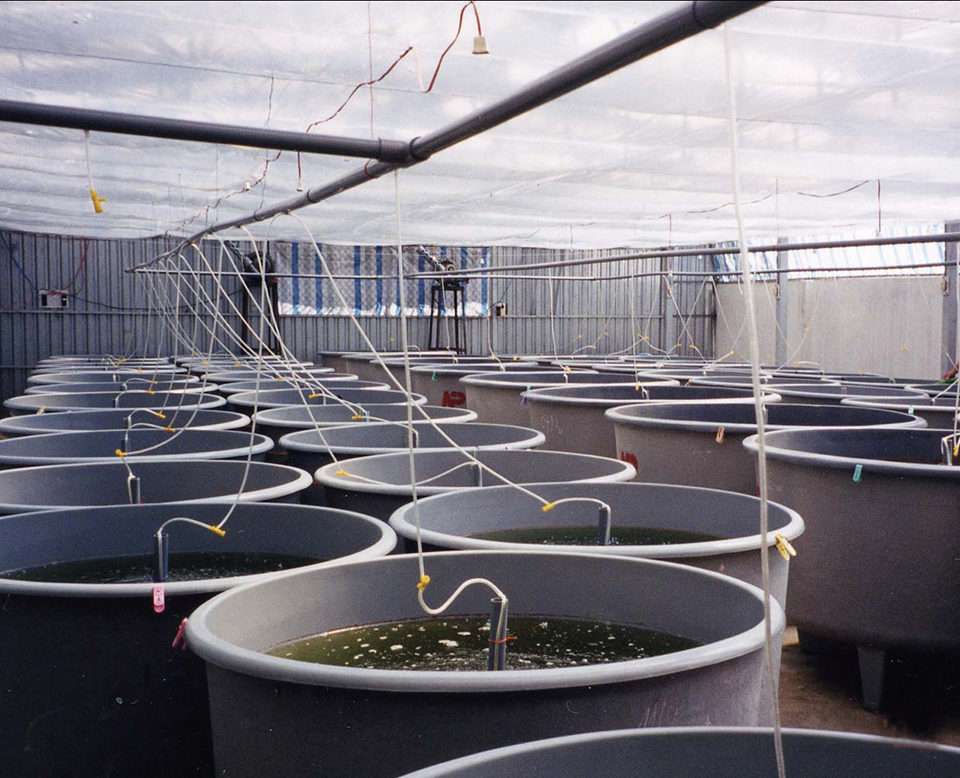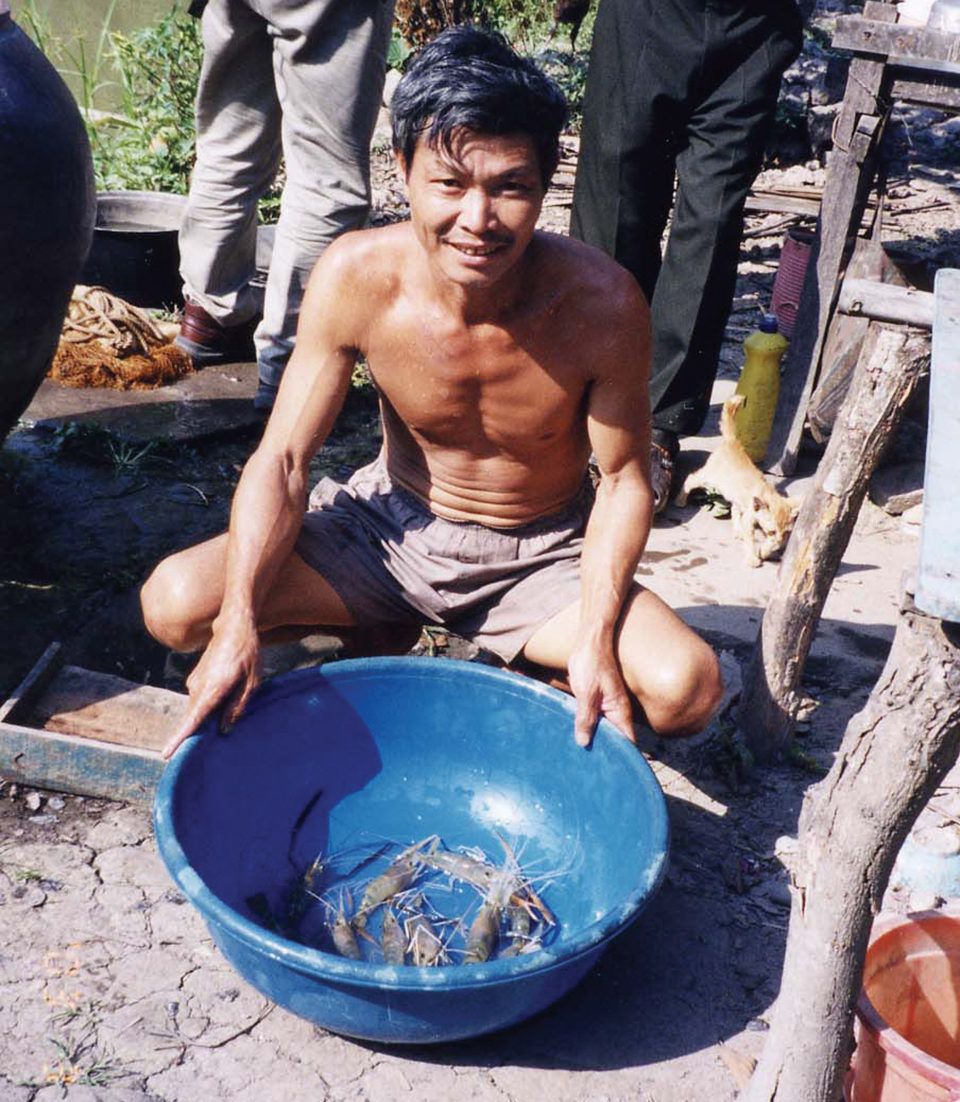Species offers diversification for Mekong Delta farmers

The Mekong Delta in southern Vietnam covers 12 percent of the total area of the country and has great potential for increased agricultural and aquacultural production. Most of Vietnam’s freshwater aquaculture production occurs in this region.
The giant freshwater prawn (Macrobrachium rosenbergii), which is indigenous to the Mekong Delta, was designated a major target species for the aquaculture sector by Vietnam’s Ministry of Fisheries in 1999. Additionally, the Vietnamese government has implemented a new policy that allows the conversion of unproductive rice land to aquaculture production that incorporates freshwater prawns. Their production is currently just over 10,000 metric tons (MT) per year, but the Vietnamese government aims to increase this level to 60,000 metric tons per year, utilizing 32,000 ha of production area by 2010.
With a combined value over U.S. $1.3 billion, black tiger shrimp and pangasius catfishes comprise the most significant components of the aquaculture industry in Vietnam. The export value of Vietnam’s freshwater prawns, however, is not reported at present, as this product is destined mainly for local markets. Prawn culture in rice fields helps impoverished farmers raise their standards of living five times higher than those obtained from rice cultivation alone.
However, until the present, one factor hampering the further development of freshwater prawn culture was the lack of a stable supply of seed due to insufficient hatchery technology.
Green water model base for seed production
Prior to 2000, most freshwater prawn culture depended on juvenile prawns collected from natural water bodies. However, the recent development of new seed production technology based on the “modified stagnant green water” model has led to the establishment of more than 90 new hatcheries in the Mekong Delta.
The production of postlarvae reached 80 million per year in 2003, a nearly 80-fold increase since the 1990s. This technology development was achieved through cooperative research carried out 1994 to 2003 between the Japan International Research Center for Agricultural Sciences and Vietnam’s Cantho University.
Initial research
Although the first freshwater prawn hatchery was established outside Ho Chi Minh City in Vung Tau in 1975, Cantho University and the Research Institute of Aquaculture No. 2 undertook initial research on the larval rearing of M. rosenbergii in the early 1980s. Various rearing systems – the open clear water system, closed clear water system, and green water system – were considered for further development, but at that time, results indicated the open clear water system was superior.
Several hatcheries near Ho Chi Minh City and in the Mekong Delta adopted the open clear water system. However, the hatcheries faced many technical and management-related difficulties that prohibited them from maintaining operations, leaving only one state-owned hatchery in Cantho City in the 1990s. Until 1998, freshwater prawn hatcheries in the Mekong Delta ceased to function, and further development of the prawn/rice-farming industry was held back by a shortage of seed.
Simple management, promising results
The authors’ cooperative research carried out a series of studies that compared recirculating and static rearing systems. It also examined the effects of rearing density, feed content and feeding regime, algal density, sources of saline water and other factors on the development and survival of freshwater prawn larvae. Due to its simple management needs and promising results, the modified stagnant green water system was selected for further development using suggested stocking densities of 60 to 90 larvae per liter.
In commercial operations in the Mekong Delta, seed production is usually practiced using 500-liter or 1-ton tanks. Feeding is done with artemia and hand-prepared custard that is easily made on site. The modified stagnant green water system – which arose from work undertaken by Ang and coworkers in Malaysia in which water quality was maintained by natural microalgae, particularly Chlorella sp., in the rearing water – performs as well or better than previous recirculating or open water larval rearing-systems.
Household application
The green water systems, which are especially suitable for use at the household scale, have been in place since 1998. Cantho University has conducted a series of training courses targeting provincial authorities and private persons to widely transfer the technology throughout the Mekong Delta and other parts of Vietnam, as well.
Although some hatcheries utilize recirculation, nearly 90 percent of the hatcheries in the Mekong Delta base their operations on the modified stagnant green water system. The hatcheries are normally small in scale, with total rearing tank volumes of 10 to 40 cubic meters. About half the hatcheries use wild broodstock, while the remaining rely on farmed broodstock. The hatcheries achieve survival rates of 20 to 90 percent from hatching to PL15, averaging 45 percent in Cantho, 36 percent in Dong Thap, and 47 percent in An Giang provinces.
Economics
The average capital investment of U.S. $2,500 spent on hatcheries does not show much deviation, but in a survey, operational costs showed a very large range of variation. A hatchery’s ability to produce postlarvae depends greatly on rearing methods and number of cycles. Data from 17 hatcheries showed an average net income of over U.S. $7,000 in 2003.

Grow-out modes
In Vietnam, M. rosenbergii are cultured using a variety of means, but prawn/rice farming and fence culture are the most important production models. The total area of rice/prawn culture was estimated as 750 ha in 2003, and fence culture consisted of 1,516 units in 2002, according to the Department of Agriculture of Dong Thap Province. Other culture modes are practiced in limited areas.
Prawn/rice farming is characterized by both integrated and alternative forms. The integrated model combines prawn culture with rice cultivation, and is considered suitable for nonflooding areas or those where two annual crops of rice are raised. However, with low productivity of 200 to 600 kilograms per hectare, small prawn size at harvest, and low survival rates, this type of culture is usually considered a subsistence activity that brings additional income to supplement rice production.
Alternative culture, in which prawn and rice cultivation are rotated, is more commercial and has become a central activity of rice farmers. Alternative culture is appropriate for locations where summer-autumn rice cultivation is subjected to high risk due to flooding. Many provincial governments in the Mekong River Delta plan to expand alternative prawn/rice culture in the coming years, as production levels are relatively high at 400 to 2,000 kilograms per hectare.
(Editor’s Note: This article was originally published in the October 2005 print edition of the Global Aquaculture Advocate.)
Now that you've finished reading the article ...
… we hope you’ll consider supporting our mission to document the evolution of the global aquaculture industry and share our vast network of contributors’ expansive knowledge every week.
By becoming a Global Seafood Alliance member, you’re ensuring that all of the pre-competitive work we do through member benefits, resources and events can continue. Individual membership costs just $50 a year. GSA individual and corporate members receive complimentary access to a series of GOAL virtual events beginning in April. Join now.
Not a GSA member? Join us.
Authors
-
Marcy N. Wilder, Ph.D.
Senior Research Scientist
Japan International Research Center for Agricultural Sciences
Tsukuba, Ibaraki Pref., Japan -
Nguyen Thanh Phuong, Ph.D.
Dean
College of Aquaculture and Fisheries
Cantho University
Cantho City, Vietnam
Tagged With
Related Posts

Intelligence
Culture of giant freshwater prawns in China
Farming of giant freshwater prawns is very popular in China. The Yangtze River Delta region produces more than 60 percent of the country's output. Production increases have resulted from a novel system that involves greenhouses that allow ponds to be stocked ahead by two months.

Intelligence
Adding flavor complexity to farmed barramundi
Organoleptic attributes such as flavor and aroma are among the most important factors that influence consumer acceptability and demand for fish products. Consumers have identified farmed fish as less complex and lacking “sealike” or “sea-fresh” flavors and aromas.

Health & Welfare
Ammonia toxicity degrades animal health, growth
Ammonia nitrogen occurs in aquaculture systems as a waste product of protein metabolism by aquatic animals and degradation of organic matter, or in nitrogen fertilizers. Exposure can reduce growth and increase susceptibility to diseases in aquatic species.

Responsibility
Freshwater prawn farming in Thailand
While the industry faces issues, freshwater prawn farming in Thailand offers a lucrative alternative to other forms of farming on small farms.


